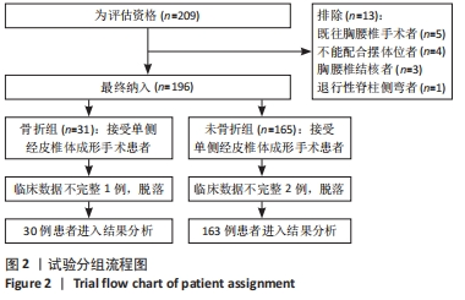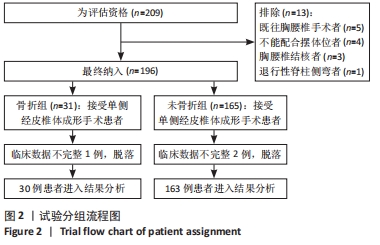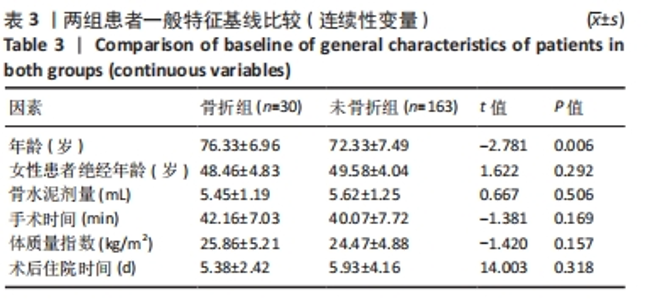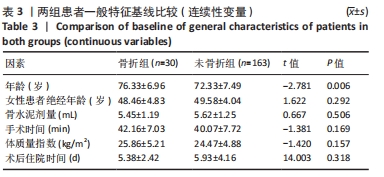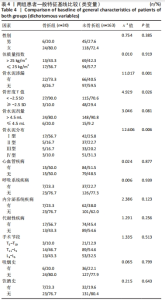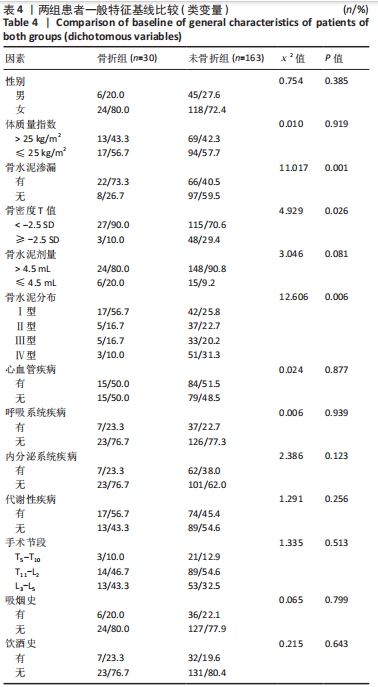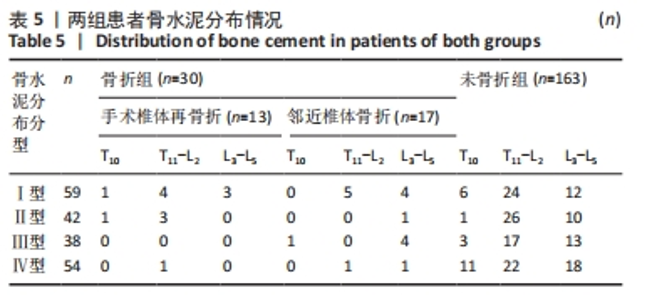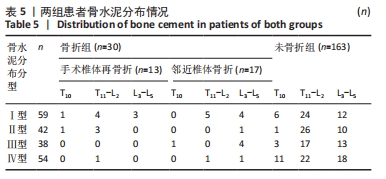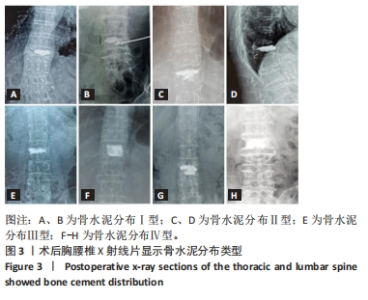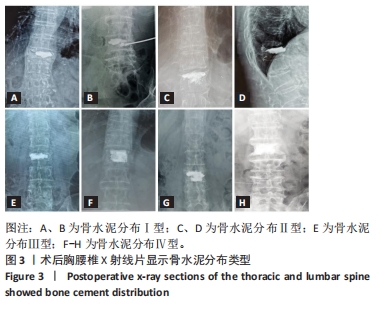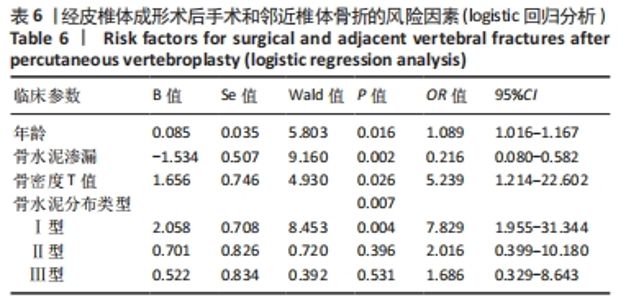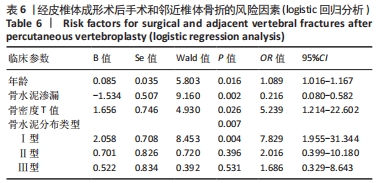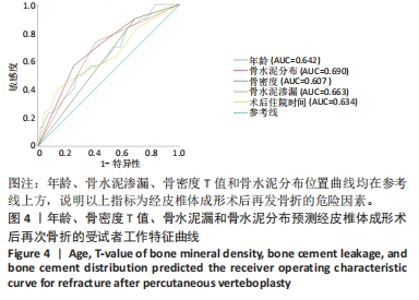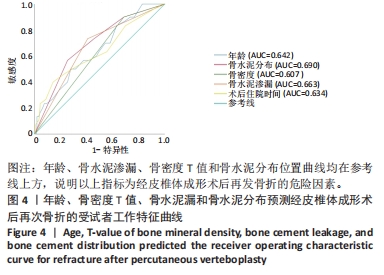Chinese Journal of Tissue Engineering Research ›› 2024, Vol. 28 ›› Issue (29): 4657-4662.doi: 10.12307/2024.813
Previous Articles Next Articles
Influence of bone cement distribution on surgical and adjacent vertebral refractures in percutaneous vertebroplasty
Abuduwupuer·Haibier1, 2, Alimujiang·Yusufu1, 2, Lin Hang1, 2, Tuerhongjiang·Abudurexiti1, 2
- 1Xinjiang Medical University, Urumqi 830054, Xinjiang Uygur Autonomous Region, China; 2Sixth Affiliated Hospital of Xinjiang Medical University (Xinjiang Uygur Autonomous Region Orthopedic Hospital), Urumqi 830002, Xinjiang Uygur Autonomous Region, China
-
Received:2023-11-14Accepted:2024-01-04Online:2024-10-18Published:2024-03-22 -
Contact:Tuerhongjiang·Abudurexiti, Master, Chief physician, Master’s supervisor, Xinjiang Medical University, Urumqi 830054, Xinjiang Uygur Autonomous Region, China; Sixth Affiliated Hospital of Xinjiang Medical University (Xinjiang Uygur Autonomous Region Orthopedic Hospital), Urumqi 830002, Xinjiang Uygur Autonomous Region, China -
About author:Abuduwupuer·Haibier, Master candidate, Xinjiang Medical University, Urumqi 830054, Xinjiang Uygur Autonomous Region, China; Sixth Affiliated Hospital of Xinjiang Medical University (Xinjiang Uygur Autonomous Region Orthopedic Hospital), Urumqi 830002, Xinjiang Uygur Autonomous Region, China -
Supported by:a grant from Department of Science and Technology of Xinjiang Uygur Autonomous Region, Youth Program of Natural Science Foundation of China, No. 2022D01C821 (to AH)
CLC Number:
Cite this article
Abuduwupuer·Haibier, Alimujiang·Yusufu, Lin Hang, Tuerhongjiang·Abudurexiti. Influence of bone cement distribution on surgical and adjacent vertebral refractures in percutaneous vertebroplasty[J]. Chinese Journal of Tissue Engineering Research, 2024, 28(29): 4657-4662.
share this article
Add to citation manager EndNote|Reference Manager|ProCite|BibTeX|RefWorks
| [1] 吴钒,黄朝靖,邱伟,等.骨质疏松椎体压缩性骨折椎体成形术后伤椎再塌陷的研究进展[J].中国中医骨伤科杂志,2023,31(8):78-81. [2] SZKODA-POLISZUK K, ZAŁUSKI R. A Comparative Biomechanical Analysis of the Impact of Different Configurations of Pedicle-Screw-Based Fixation in Thoracolumbar Compression Fracture. Appl Bionics Biomech. 2022;2022:3817097. [3] LUO Y, JIANG T, GUO H, et al. Osteoporotic vertebral compression fracture accompanied with thoracolumbar fascial injury: risk factors and the association with residual pain after percutaneous vertebroplasty. BMC Musculoskelet Disord. 2022;23(1):343. [4] ZHANG W, LIU S, LIU X, et al. Unilateral percutaneous vertebroplasty for osteoporotic lumbar compression fractures: a comparative study between transverse process root-pedicle approach and conventional transpedicular approach. J Orthop Surg Res. 2021;16(1):73. [5] BAO LS, WU W, ZHONG XH, et al. [Effect of bone cement distribution on the clinical outcome of unilateral transpedicular puncture for spinal osteoporotic fractures]. Zhongguo Gu Shang. 2022;35(5):423-429. [6] WEI Y, BASKARAN N, WANG HY, et al. Study of polymethylmethacrylate/tricalcium silicate composite cement for orthopedic application. Biomed J. 2023;46(3):100540. [7] MIAO F, ZENG X, WANG W, et al. Percutaneous vertebroplasty with high- versus low-viscosity bone cement for osteoporotic vertebral compression fractures. J Orthop Surg Res. 2020;15(1):302. [8] 徐敏,张鸿升,王继,等.高黏度与低黏度骨水泥经皮椎体成形治疗骨质疏松椎体压缩性骨折的Meta分析[J].中国组织工程研究, 2017,21(34):5571-5576. [9] LAI PL, CHEN LH, CHEN WJ, et al. Chemical and physical properties of bone cement for vertebroplasty. Biomed J. 2013;36(4):162-167. [10] MOLLOY S, RILEY LH 3RD, BELKOFF SM. Effect of cement volume and placement on mechanical-property restoration resulting from vertebroplasty. AJNR Am J Neuroradiol. 2005;26(2):401-404. [11] 阿卜杜吾普尔·海比尔,阿里木江·玉素甫,麦麦提敏·阿卜力米提,等.经皮椎体成形术后骨水泥量和分布对手术椎体及邻近椎体再发骨折的影响[J].中国组织工程研究,2024,28(10):1586-1591. [12] JU G, LIU X. A nomogram prediction model for refracture in elderly patients with osteoporotic vertebral compression fractures after percutaneous vertebroplasty. Eur Spine J. 2023;32(11):3919-3926. [13] LIANG L, CHEN X, JIANG W, et al. Balloon kyphoplasty or percutaneous vertebroplasty for osteoporotic vertebral compression fracture? An updated systematic review and meta-analysis. Ann Saudi Med. 2016;36(3):165-174. [14] YU W, XU W, JIANG X, et al. Risk Factors for Recollapse of the Augmented Vertebrae After Percutaneous Vertebral Augmentation: A Systematic Review and Meta-Analysis. World Neurosurg. 2018;111: 119-129. [15] KWEH BTS, LEE HQ, TAN T, et al. The Role of Spinal Orthoses in Osteoporotic Vertebral Fractures of the Elderly Population (Age 60 Years or Older): Systematic Review. Global Spine J. 2021;11(6):975-987. [16] NIU J, ZHOU H, MENG Q, et al. Factors affecting recompression of augmented vertebrae after successful percutaneous balloon kyphoplasty: a retrospective analysis. Acta radiol. 2015;56(11): 1380-1387. [17] ZHANG L, WANG Q, WANG L, et al. Bone cement distribution in the vertebral body affects chances of recompression after percutaneous vertebroplasty treatment in elderly patients with osteoporotic vertebral compression fractures. Clin Interv Aging. 2017;12:431-436. [18] HAIBIER A, YUSUFU A, LIN H, et al. Effect of different cement distribution in bilateral and unilateral Percutaneous vertebro plasty on the clinical efficacy of vertebral compression fractures. BMC Musculoskelet Disord. 2023;24(1):908. [19] LIANG X, ZHONG W, LUO X, et al. Risk factors of adjacent segmental fractures when percutaneous vertebroplasty is performed for the treatment of osteoporotic thoracolumbar fractures. Sci Rep. 2020; 10(1):399. [20] ZHANG Z, FAN J, DING Q, et al. Risk factors for new osteoporotic vertebral compression fractures after vertebroplasty: a systematic review and meta-analysis. J Spinal Disord Tech. 2013;26(4):E150-157. [21] 吕文,刘艺明,陈光,等.经横突根部单侧穿刺的改良PVP与PCVP技术治疗腰椎骨质疏松性骨折的疗效对比[J].颈腰痛杂志, 2020,41(2):154-157. [22] 崔志远,毛兆虎,刘玉林,等.单侧PVP术对OVCF术后椎体高度恢复及疼痛程度的效果研究[J].中国医药导报,2021,18(18):92-95. [23] 罗伟斌,林勇,孙春喜,等.经皮椎体成形术术后新发椎体骨折特点及危险因素分析[J].中国医药科学,2021,11(10):210-212,224. [24] LIN S, CAI X, CHENG Q, et al. Association between bone turnover markers, BMD and height loss of cemented vertebrae after percutaneous vertebroplasty in patients with osteoporotic vertebral compression fractures. J Orthop Surg Res. 2022;17(1):202. [25] AN Z, CHEN C, WANG J, et al. Logistic regression analysis on risk factors of augmented vertebra recompression after percutaneous vertebral augmentation. J Orthop Surg Res. 2021;16(1):374. [26] HOU Y, YAO Q, ZHANG G, et al. Polymethylmethacrylate distribution is associated with recompression after vertebroplasty or kyphoplasty for osteoporotic vertebral compression fractures: A retrospective study. PLoS One. 2018;13(6):e0198407. [27] 曹冬子,许正伟,王存良,等.老年骨质疏松性椎体压缩骨折经皮椎体后凸成形术后新发骨折的危险因素分析[J].空军医学杂志, 2018,34(1):41-44. [28] LI YX, GUO DQ, ZHANG SC, et al. Risk factor analysis for re-collapse of cemented vertebrae after percutaneous vertebroplasty (PVP) or percutaneous kyphoplasty (PKP). Int Orthop. 2018;42(9):2131-2139. [29] YU W, ZHANG H, YAO Z, et al. Prediction of subsequent vertebral compression fractures after thoracolumbar kyphoplasty: a multicenter retrospective analysis. Pain Med. 2023;24(8):949-956. |
| [1] | Xi Jintao, Lu Qilin, Wang Yang, Wang Xiaojuan, Lyu Peng, Chen Long, Shi Zhen, Xie Wei, Zhu Yiliang, Li Xugui. Risk factors for cage retropulsion following transforaminal lumbar interbody fusion [J]. Chinese Journal of Tissue Engineering Research, 2024, 28(9): 1394-1398. |
| [2] | Yang Cekai, Cai Zhuoyan, Chen Ming, Liu Hao, Weng Rui, Cui Jianchao, Zhang Shuncong, Yao Zhensong. Relationship between degeneration of paraspinal muscle and refractures in postmenopausal women treated by percutaneous vertebroplasty [J]. Chinese Journal of Tissue Engineering Research, 2024, 28(9): 1414-1419. |
| [3] | Han Bing, Liu Hongbin, Wang Hehong, Zhao Hanqing, Zhao Riguang, Sun Yiyan, Zhang Yu. Correlation between lower limb alignment and risk factors of patellofemoral pain syndrome in young men [J]. Chinese Journal of Tissue Engineering Research, 2024, 28(8): 1211-1216. |
| [4] | Tong Yibo, Li Minghui. Influencing factors of adjacent vertebral re-fracture in patients with osteoporotic vertebral fractures after percutaneous vertebroplasty [J]. Chinese Journal of Tissue Engineering Research, 2024, 28(8): 1241-1246. |
| [5] | Wang Haotian, Wu Mao, Yang Junfeng, Shao Yang, Li Shaoshuo, Yin Heng, Yu Hao, Wang Guopeng, Tang Zhi, Zhou Chengwei, Wang Jianwei. Postoperative pulmonary infection in elderly patients with hip fracture: construction of a nomogram model for influencing factors and risk prediction [J]. Chinese Journal of Tissue Engineering Research, 2024, 28(36): 5785-5792. |
| [6] | Wang Xiaopeng, Zhong Rong, Zhong Yan, Lin Feng, Ye Shuxi. Influencing factors of adjacent vertebral refracture in elderly female patients with osteoporotic vertebral compression fracture and construction of a prediction model based on Nomogram [J]. Chinese Journal of Tissue Engineering Research, 2024, 28(36): 5799-5804. |
| [7] | Liu Dongyuan, Guan Haishan, Shi Haoran, Liu Xiaoliang, Zhou Haosheng. Risk factors for adjacent vertebral compression fractures after percutaneous vertebroplasty [J]. Chinese Journal of Tissue Engineering Research, 2024, 28(36): 5884-5891. |
| [8] | Shang Peng, Cui Lunxu, Ma Benyuan, Hou Guanghui, Song Wanzhen, Liu Yancheng. Effect of restored height on neighboring vertebrae after vertebral body strengthening: a finite element analysis [J]. Chinese Journal of Tissue Engineering Research, 2024, 28(36): 5741-5746. |
| [9] | Xia Guoren, Yu Hao, Jiang Shifeng, Peng Xin, Fu Xiao, Chen Qi, Yang Lizhuang, Wang Tengfei, Li Hai. Biomechanical characteristics of thoracic T10 bone tumor metastasis at different locations: three-dimensional finite element analysis [J]. Chinese Journal of Tissue Engineering Research, 2024, 28(36): 5759-5765. |
| [10] | Li Yan, Liu Ning, Wang Xiaoyang, Xiao Xiangyu, Liu Ping, Zhang Yili, Jiang Hongjiang, Zhu Liguo, Wei Xu. Bibliometric and visual analysis of postmenopausal osteoporosis based on highly cited SCI papers [J]. Chinese Journal of Tissue Engineering Research, 2024, 28(35): 5681-5687. |
| [11] | Chen Junfeng, Xie Rongzhen, Hong Weishi, Sun Yu. Risk factors and establishment of a nomogram prediction model for hypoproteinemia after hip revision [J]. Chinese Journal of Tissue Engineering Research, 2024, 28(30): 4837-4841. |
| [12] | Ma Chao, Ding Jiangping, Wang Bin, Niu Ben, Muhetaer•Wumaier, Tang Guozhu, Yang Hongtao, Feng Xinwen. Relationship between bone cement-vertebral volume ratio and therapeutic effect of osteoporotic vertebral compression fractures [J]. Chinese Journal of Tissue Engineering Research, 2024, 28(29): 4652-4656. |
| [13] | Huang Dong, Ge Jin, Liu Guangluan, Guo Zonglei, Wang Yehua. Anatomical risk factors for tibial insertion avulsion fracture of anterior cruciate ligament based on MRI [J]. Chinese Journal of Tissue Engineering Research, 2024, 28(24): 3890-3896. |
| [14] | Li Zhipeng, Huan Dawei, Yuan Zhaofeng, Qiu Yue, Zhang Chao, Xia Tianwei, Shen Jirong. Risk factors of postoperative mortality of femoral neck fractures in elderly patients and construction of a nomogram predictive model [J]. Chinese Journal of Tissue Engineering Research, 2024, 28(21): 3361-3366. |
| [15] | Wang Dening, Zhang Kefan, Shi Hui, Du Changling, Wang Xin. Imaging analysis of anatomical morphological risk factors for posterior cruciate ligament injury of the knee [J]. Chinese Journal of Tissue Engineering Research, 2024, 28(18): 2887-2894. |
| Viewed | ||||||
|
Full text |
|
|||||
|
Abstract |
|
|||||
